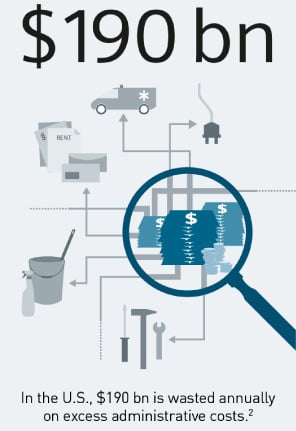HealthManagement, Volume 16 - Issue 4, 2016
Precisely Defining Indirect Overhead Costs or Diagnosis/Treatment-related Expenses is a Challenge
Certain operating expenses are necessary to keep businesses functioning. However, in healthcare, drawing clear boundaries between diagnosis/treatment-related expenses and overhead costs is not always easy. In some cases, overhead expenses might even improve the overall economic performance of a hospital.

Overhead Costs are Unavoidable to a Certain Degree
Overhead costs are expenses that are not directly attributable to a patient’s medical care. Among other things, they can include governance and documentation, billing, or supplies. In many cases, however, there seems to be no precise definition for indirect overhead costs and direct, diagnosis/treatment- related expenses. Examples of these hard-to-define costs include things such as labs and laundry.1 Still, setting out to reduce overhead costs across the board would be a mistake. Hospital operators who reduce avoidable overhead costs and invest in overhead expenses that create value and improve overall economic performance and medical care will increase their competitiveness.
Rising Costs and High Administrative Expenses Worldwide
In the U.S. healthcare system, $750 billion is spent annually on expenses that are not directly linked to healthcare.2 The causes of unnecessary spending vary widely, but generally point toward administrative expenses. A study of hospital administrative costs in several countries found that costs are highest in the U.S., where they consumed 25.3% of hospital budgets in 2011. Administrative costs were lowest in countries operating under single-payer health systems, such as Scotland and Canada. There, hospitals are payed global operating budgets, with separate grants for capital, which results in administrative costs of around 12%. Reducing U.S. per capita spending on hospital administration to Scottish or Canadian levels would have saved more than $150 billion in 2011.3
Complexity and Competition as Cost Drivers
According to the survey, the high administrative costs in the U.S. are caused by, among other things, the complexity of the health system and billing multiple insurers. Another cause is the need for hospitals to generate a profit (or, for non-profit hospitals, surpluses) in order to fund the modernization and upgrades that are essential to survival. Paradoxically, this entrepreneurial imperative and the reliance on market mechanisms raises administrative costs and reduces efficiency – due to, for example, higher marketing expenses and the need to provide high-volume services.3
Allocating Overhead Costs Correctly
According to Australia’s Independent Hospital Pricing Authority, all costs accumulated in overhead costs centers should be allocated to the final cost to ensure that each product category (patient and non-patient) has its fair share of overhead. This should be done before making any attempt to partition costs into product categories and subsequently into end classes within product categories.4 Incorrect allocation impedes or prevents intervention measures to reduce costs. Conversely, it becomes more complicated to make targeted and useful investments in overhead expenses where the investment creates demonstrable added value.
Learning from Other Industries
For healthcare providers, it would be wise to look to successful cost-efficiency measures in other industries, such as the manufacturing industry. There, such factors as short throughput, optimum utilization, minimum downtime, and low error rates are undisputed determinants of success, and high levels of attention and planning are devoted to them. In Germany, the introduction of fixed prices for DRGs made it indispensable to have an accurate grasp of the entire treatment process, its time requirements, and its direct costs (e.g. physician time) and overhead costs.5
Optimization Potential in Service Billing
One of the most effective ways to reduce overhead costs is to optimize the recording and billing of the services provided. In the U.S., healthcare providers manually handle around 28% of eligibility transactions, which accounted for more than 2.4 billion transactions in 2013.6 The potential for significant cost savings is enormous. The estimated cost for a manual transaction is roughly $5, while an electronic transaction is approximately $1.60. Thus, U.S. healthcare providers could save a total of approximately $7 billion annually by switching six routine business transactions from manual to electronic.6 This represents an average savings potential of 86% compared to the costs of manual transactions.
IT as a Cost Reducer
Enhancing efficiency through comprehensive and flexible digitalization of hospital processes is essential in the long term to counteract the overhead costs caused by complexity and a lack of transparency. One problem with today’s IT systems is that their concepts are too rigid, they are often operated as standalone solutions, and they are not sufficiently interconnected. A study by the management consultancy A.T. Kearney says that only carefully coordinated processes within the IT system can guarantee an accurate management of processes and thus reduce the administrative burden.7 The authors add that communication processes through third parties should be eliminated, as lean information flows would reduce interfaces and thus save money.
In a Nutshell
Overhead Challenges in Healthcare
- The most important prerequisite in eliminating avoidable
overhead costs is to precisely define and record these costs, and allocate them
properly. This is crucial in order to control these costs in a sensible way.
- In terms of value, overhead costs are not necessarily
economic burdens. They can contribute to higher levels of cost efficiency and
care quality. However, costs that do not contribute to a higher quality of care
should and must be reduced.
- Hospitals in countries with particularly complex health
systems and highly competitive markets tend to operate under the highest
overhead costs.
- There is considerable potential for optimization in the area
of service accounting. The increasing use of electronic transactions helps to
avoid unnecessary overhead costs.
- Like other industries, healthcare providers have financial
considerations. Benchmarking with other industries and investing in a
management team that is well trained and experienced in business administration
helps optimize overhead costs.
- Comprehensive, flexible digitization of healthcare processes
can be key to increasing cost transparency and process quality, systematically
controlling overhead costs, and ultimately increasing cost efficiency and care quality
in the long term.

